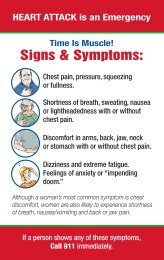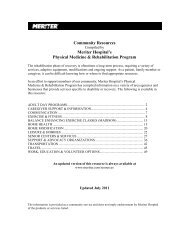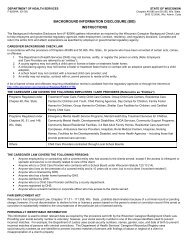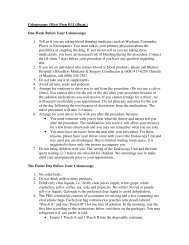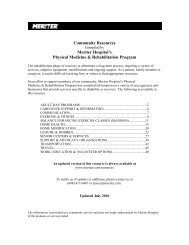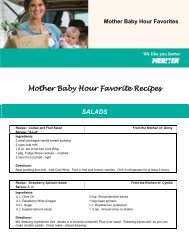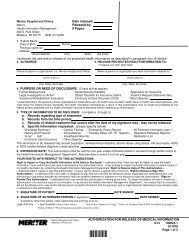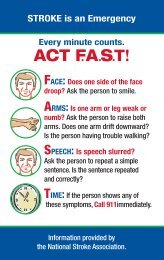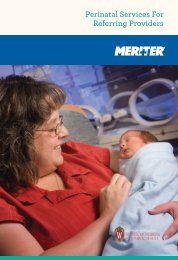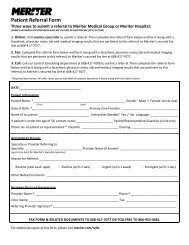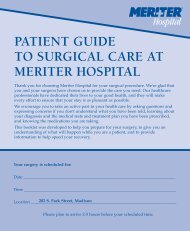The Mission of NewStart is to provide a - Meriter Health Services
The Mission of NewStart is to provide a - Meriter Health Services
The Mission of NewStart is to provide a - Meriter Health Services
Create successful ePaper yourself
Turn your PDF publications into a flip-book with our unique Google optimized e-Paper software.
®<br />
A PROGRAM OF HEALING FOR ALCOHOL AND DRUG USE DISORDERS<br />
<strong>The</strong> <strong>M<strong>is</strong>sion</strong> <strong>of</strong> <strong>NewStart</strong> <strong>is</strong> <strong>to</strong> <strong>provide</strong> a comprehensive<br />
network <strong>of</strong> treatment, education, and referral services for<br />
persons with alcohol or other substance use d<strong>is</strong>orders, and<br />
others affected by the patient’s substance use.<br />
VOLUME XXVI FALL 2006<br />
DIRECTORY OF SERVICES<br />
Addiction Medicine Consultation<br />
and Evaluation <strong>Services</strong> (AMCES)<br />
202 S. Park Street<br />
Mad<strong>is</strong>on, W<strong>is</strong>consin 53715<br />
(Ph) 608-267-5339<br />
(Fax) 608-267-6687<br />
• Addiction Medicine<br />
Consultation and Evaluation<br />
• Information and Referral<br />
• Chemical Dependency Assessment<br />
• Emergency <strong>Services</strong><br />
• Medical Inpatient De<strong>to</strong>xification<br />
• Nursing Evaluation<br />
• Referral <strong>Services</strong><br />
Outpatient <strong>Services</strong> and<br />
Adolescent Program<br />
1015 Gammon Lane<br />
Mad<strong>is</strong>on, W<strong>is</strong>consin 53719<br />
(Ph) 608-271-4144<br />
(Fax) 608-271-3457<br />
• Assessment and Referral Service<br />
• Adolescent Intensive Outpatient Program<br />
• Adult Intensive Outpatient Program<br />
• Adult Day Treatment<br />
• Individual, Group, and Family<br />
Counseling for Chemical Dependency<br />
and for Family Members<br />
• Chemical Awareness Programs<br />
Inpatient <strong>Services</strong><br />
Unit 1 East<br />
202 S. Park Street<br />
Mad<strong>is</strong>on, W<strong>is</strong>consin 53715<br />
(Ph) 608-267-5330<br />
(Fax) 608-267-5334<br />
• Adult Inpatient Rehabilitation <strong>Services</strong><br />
IN THIS ISSUE…<br />
Direc<strong>to</strong>ry <strong>of</strong> <strong>Services</strong> ..........................................1<br />
<strong>NewStart</strong> Benefits From <strong>Meriter</strong> Foundation............1<br />
<strong>NewStart</strong> Adolescent Staff Gains a New <strong>The</strong>rap<strong>is</strong>t ....2<br />
<strong>NewStart</strong> Staff Gains New Support Person ..............2<br />
<strong>NewStart</strong> Addiction Medicine Consultation and<br />
Evaluation Service News......................................2<br />
Resources available on the Internet ......................2<br />
Compassion, palliative care and <strong>NewStart</strong> ...........2-3<br />
One For <strong>The</strong> Road ...............................................3<br />
September <strong>is</strong> National Recovery Month..................3<br />
Adolescent Substance Use & Addiction: Trends .....4-5<br />
Drug Testing <strong>of</strong> Students: Varying Perspectives ....6-7<br />
NEWSTART’S SCOPE OF TREATMENT<br />
<strong>NewStart</strong> <strong>is</strong> the sole remaining hospitalbased<br />
treatment program for alcohol and drug<br />
use d<strong>is</strong>orders in South-Central W<strong>is</strong>consin.<br />
<strong>NewStart</strong> continues <strong>to</strong> <strong>of</strong>fer a full continuum<br />
<strong>of</strong> services including outpatient, intensive<br />
outpatient, and full-day treatment;<br />
de<strong>to</strong>xification; and inpatient rehabilitation<br />
services. <strong>NewStart</strong> remains one <strong>of</strong> the few<br />
local <strong>provide</strong>rs which accepts fee-for-service<br />
Medical Ass<strong>is</strong>tance patients. <strong>NewStart</strong><br />
counseling staff are all certified <strong>to</strong> <strong>provide</strong><br />
addiction treatment services through the<br />
W<strong>is</strong>consin Certification Board, and all are<br />
Masters-prepared. In our current twophysician<br />
model <strong>of</strong> care, 24-hour coverage <strong>is</strong><br />
available for emergency room and hospital<br />
consults and inpatient coverage while allowing<br />
for cons<strong>is</strong>tent availability <strong>of</strong> physician services<br />
in our outpatient clinic every week.<br />
NEWSTART BENEFITS FROM<br />
MERITER FOUNDATION<br />
<strong>Meriter</strong> foundation continues <strong>to</strong> be a source<br />
<strong>of</strong> innovation and support for <strong>NewStart</strong>. <strong>The</strong><br />
foundation has funded three important projects<br />
in the past year. One project included<br />
updating the adolescent treatment milieu.<br />
That <strong>is</strong> a fancy word for making the adolescent<br />
room look like a room adolescents’ can enjoy.<br />
Through the generosity <strong>of</strong> the <strong>Meriter</strong> Foundation<br />
a Foosball Table was purchased, the adolescent<br />
room was decorated and other necessary<br />
treatment activity supplies were purchased.<br />
<strong>The</strong> second project was continued education<br />
for all therap<strong>is</strong>ts; the entire <strong>NewStart</strong><br />
staff was able <strong>to</strong> attend the WAAODA conference<br />
which included various <strong>to</strong>pics <strong>to</strong> help<br />
improve patient care and clinical expert<strong>is</strong>e.<br />
New research and clinically proven seminars<br />
were made available <strong>to</strong> all the staff.<br />
<strong>The</strong> third project allowed the <strong>NewStart</strong><br />
AMCES <strong>provide</strong>rs <strong>to</strong> attend the National nursing<br />
Conference. As <strong>NewStart</strong>, continues <strong>to</strong><br />
<strong>provide</strong> quality and up <strong>to</strong> date services the<br />
financial support <strong>of</strong> the <strong>Meriter</strong> Foundation <strong>is</strong><br />
greatly appreciated by all levels <strong>of</strong> service at<br />
<strong>NewStart</strong>.<br />
A PROGRAM OF HEALING FOR ALCOHOL AND DRUG USE DISORDERS<br />
1
NEWSTART ADOLESCENT STAFF GAINS<br />
A NEW THERAPIST<br />
<strong>The</strong> <strong>NewStart</strong> Adolescent Program<br />
continues <strong>to</strong> <strong>provide</strong> the unique Intensive<br />
Adolescent Outpatient Program that supports<br />
abstinence from all mood altering<br />
substances. Now the Adolescent services<br />
also has the benefit <strong>of</strong> the expert<strong>is</strong>e <strong>of</strong> Hannah<br />
Flanagan. Th<strong>is</strong> energetic woman also<br />
works at the <strong>Meriter</strong> Adolescent Inpatient<br />
Psychiatric Program. Ms. Flanagan was<br />
born and ra<strong>is</strong>ed in LaCrosse has traveled <strong>to</strong><br />
UW Eau Claire <strong>to</strong> attain her BA in Psychology,<br />
<strong>to</strong> Flagstaff Arizona, <strong>to</strong> Portland Oregon<br />
for four years and then returned <strong>to</strong><br />
Mad<strong>is</strong>on attaining her Masters Degree at<br />
Edgewood College in Marriage and Family<br />
<strong>The</strong>rapy. We are hoping she has returned <strong>to</strong><br />
Mad<strong>is</strong>on for a long time. Ms. Flanagan not<br />
only brings great clinical expert<strong>is</strong>e <strong>to</strong><br />
<strong>NewStart</strong>, she also brings a playfulness and<br />
creativity that <strong>is</strong> appreciated by the staff,<br />
the adolescents and their parents.<br />
NEWSTART STAFF GAINS NEW<br />
SUPPORT PERSON<br />
Brenda Bell<strong>is</strong>le has joined the <strong>NewStart</strong><br />
Support Team. You may recognize her<br />
because she has been with <strong>Meriter</strong> for 17<br />
years. She started in the brand new Children’s<br />
Center. <strong>The</strong> Children’s Center was<br />
fortunate enough <strong>to</strong> have Ms. Bell<strong>is</strong>le for<br />
11 years until she “spread her wings” and<br />
Brenda Bell<strong>is</strong>le<br />
transferred <strong>to</strong> Guest <strong>Services</strong> for 3 enjoyable<br />
years. She had a brief stint in Complementary<br />
Medicine until that clinic closed. She<br />
then worked in the Gift Shop at <strong>Meriter</strong>.<br />
<strong>NewStart</strong> was fortunate enough <strong>to</strong> gain<br />
Ms. Bell<strong>is</strong>le’s expert<strong>is</strong>e in June <strong>of</strong> 2006.<br />
If you have ever worked with or seen<br />
Ms. Bell<strong>is</strong>le at <strong>Meriter</strong>, you will know that<br />
<strong>NewStart</strong> <strong>is</strong> benefiting from her presence.<br />
She has caught on quickly <strong>to</strong> the <strong>NewStart</strong><br />
system. <strong>The</strong> <strong>NewStart</strong> staff and clients are<br />
enjoying her smile and if you call <strong>NewStart</strong>,<br />
you may have Ms. Bell<strong>is</strong>le answer your call<br />
in a very pleasant, helpful manner.<br />
NEWSTART ADDICTION MEDICINE<br />
CONSULTATION AND EVALUATION<br />
SERVICE NEWS<br />
<strong>NewStart</strong>’s Addiction Medicine Consultation<br />
and Evaluation Service nurse, Kathryn<br />
Curio, RN, MSN, has attained certification<br />
by examination in addictions nursing. Th<strong>is</strong><br />
level <strong>of</strong> expert<strong>is</strong>e <strong>is</strong> designated with the credential<br />
<strong>of</strong> CARN-AP (Certified Addictions<br />
Reg<strong>is</strong>tered Nurse – Advanced Practice).<br />
<strong>The</strong> Addictions Nursing Certification Board<br />
admin<strong>is</strong>tered the first certification examination<br />
in addictions for Reg<strong>is</strong>tered Nurses<br />
(CARN) in 1989, leading <strong>to</strong> the first examination<br />
for CARN – AP in 2000. To date, more<br />
than 2600 nurses have taken the CARN and<br />
over 50 nurses with master’s degrees have<br />
taken the CARN- AP. We acknowledge and<br />
congratulate Kathryn on her commitment<br />
<strong>to</strong> excellence as a CARN – AP.<br />
Two <strong>of</strong> our certified addiction nurses<br />
have advanced in the <strong>Meriter</strong> Clinical<br />
Recognition Program <strong>to</strong> achieve Clinical<br />
Nurse II status. Ann Frank, RN, CARN and<br />
Jan Snortum, RN, CARN completed the<br />
requirements set forth by the Central<br />
Review Committee at t <strong>Meriter</strong> Hospital.<br />
<strong>The</strong> <strong>Meriter</strong> Clinical Recognition Program<br />
was establ<strong>is</strong>hed <strong>to</strong> recognize and reward<br />
pr<strong>of</strong>essional nursing staff members who<br />
have demonstrated exceptional clinical<br />
competency, pr<strong>of</strong>essional behavior and<br />
knowledge.<br />
Ann Frank joined the <strong>NewStart</strong><br />
Addiction Medicine Consultation and<br />
Evaluation Service (AMCES) at <strong>Meriter</strong> –<br />
Park in 1998 and has been certified in<br />
addictions nursing since 1999. Jan Snortum<br />
transferred <strong>to</strong> AMCES in 2001 and obtained<br />
her certified addictions reg<strong>is</strong>tered nurse<br />
(CARN) designation in 2003.<br />
We congratulate them on th<strong>is</strong> new<br />
achievement and recognize the important<br />
role that they play in meeting the needs <strong>of</strong><br />
patients and families dealing with alcohol<br />
and substance use d<strong>is</strong>orders. We are pleased<br />
<strong>to</strong> have them as part <strong>of</strong> our treatment team.<br />
RESOURCES AVAILABLE ON THE<br />
INTERNET<br />
<strong>The</strong>re are so many resources available<br />
on the internet these days. We would like<br />
<strong>to</strong> suggest a few sites that you may find<br />
helpful. <strong>The</strong>se sites also have links you may<br />
find helpful:<br />
http://www.meriter.com/mhs/hospital/<br />
newstart.htm<br />
At th<strong>is</strong> site you can read the newsletter<br />
on line, look up support group information,<br />
find out more about <strong>NewStart</strong> services and<br />
read more articles.<br />
http://www.theantidrug.com<br />
At th<strong>is</strong> site you will find information<br />
primarily for parents who are concerned<br />
about their children’s use <strong>of</strong> chemicals:<br />
news, drug information, <strong>is</strong> your teen<br />
using?, and other resources.<br />
http://www.nida.nih.gov<br />
At th<strong>is</strong> site you will find drug<br />
information and facts that are kept up <strong>to</strong><br />
date especially for parents.<br />
http://www.drugs.com/<br />
pill_identification.html<br />
At th<strong>is</strong> site you will be able <strong>to</strong> access<br />
a Pill Identification Wizard <strong>to</strong> help you<br />
identify pills or capsules that you may have<br />
found.<br />
http://www.drugfree.org/<br />
At th<strong>is</strong> site you will be able <strong>to</strong> find<br />
information for parents and for teens.<br />
Th<strong>is</strong> <strong>is</strong> the Partnership for a Drug Free site.<br />
COMPASSION, PALLIATIVE CARE<br />
AND NEWSTART<br />
Addiction permeates the American culture.<br />
It <strong>is</strong> responsible for much suffering in<br />
the lives <strong>of</strong> many people. How should we<br />
respond <strong>to</strong> such pain, suffering and loss?<br />
Th<strong>is</strong> article will d<strong>is</strong>cuss one alternative for<br />
responding: compassion. It will define com-<br />
2<br />
<strong>NewStart</strong> Volume XXVI • Fall 2006
passion, compare the response <strong>of</strong> palliative<br />
care <strong>to</strong> AODA treatment, and finally<br />
will describe what <strong>NewStart</strong> <strong>is</strong> doing <strong>to</strong><br />
respond <strong>to</strong> th<strong>is</strong> d<strong>is</strong>ease.<br />
Compassion<br />
Looking at two important religious<br />
traditions gives insight in<strong>to</strong> the meaning<br />
<strong>of</strong> compassion.<br />
Buddh<strong>is</strong>m prescribes compassion as<br />
a response <strong>to</strong> anger. When we feel<br />
compassion for a person it <strong>is</strong> difficult if<br />
not impossible <strong>to</strong> feel anger at the same<br />
time. Compassion <strong>is</strong> gown through<br />
meditation. If a person meditates on the<br />
suffering <strong>of</strong> all living beings there <strong>is</strong><br />
a greater capacity <strong>to</strong> respond <strong>to</strong> people<br />
without anger. So the first response our<br />
society needs <strong>to</strong> the problem <strong>of</strong> addiction<br />
<strong>is</strong> compassion. <strong>The</strong> first step in th<strong>is</strong><br />
response <strong>is</strong> <strong>to</strong> meditate.<br />
Chr<strong>is</strong>tianity prescribes self examination<br />
<strong>to</strong> avoid judging your brother. “How<br />
do you expect <strong>to</strong> take that out <strong>of</strong> your<br />
brother’s eye with a plank in your own.”<br />
Look within yourself at your own suffering<br />
so that you can respond appropriately<br />
<strong>to</strong> others.<br />
Palliative Care<br />
Goal <strong>of</strong> palliative care <strong>is</strong> <strong>to</strong> relieve<br />
suffering. Palliative care does not seek so<br />
much <strong>to</strong> cure a d<strong>is</strong>ease but <strong>to</strong> control<br />
symp<strong>to</strong>ms. Palliative care seeks <strong>to</strong> <strong>provide</strong><br />
for a full and comfortable life until death.<br />
Th<strong>is</strong> <strong>is</strong> prec<strong>is</strong>ely what AODA treatment<br />
<strong>provide</strong>rs hope <strong>to</strong> <strong>provide</strong> for their<br />
patients/clients/consumers. Addiction <strong>is</strong><br />
a condition that <strong>is</strong> potentially fatal, primary,<br />
and progressive. <strong>The</strong>re <strong>is</strong> no ultimate<br />
cure, nor a magical treatment. <strong>The</strong><br />
only treatment <strong>is</strong> <strong>to</strong> control the symp<strong>to</strong>ms<br />
so that the person has the potential for<br />
a joyful, productive, and happy life.<br />
<strong>NewStart</strong><br />
<strong>NewStart</strong> seeks <strong>to</strong> be <strong>of</strong> service <strong>to</strong><br />
those who suffer from addiction, both<br />
the user and the family <strong>of</strong> the user.<br />
We <strong>provide</strong> care at any level the<br />
patient/client/consumer needs. We are<br />
the last <strong>provide</strong>r in southern W<strong>is</strong>consin <strong>to</strong><br />
<strong>provide</strong> the full continuum <strong>of</strong> care for<br />
those who suffer because <strong>of</strong> addiction.<br />
MADISON (August 10, 2006) — Governor<br />
Jim Doyle recently proclaimed September<br />
as alcohol and other drug abuse Recovery<br />
Month in W<strong>is</strong>consin. <strong>The</strong> W<strong>is</strong>consin Association<br />
on Alcohol and Other Drug Abuse<br />
(WAAODA) <strong>is</strong> celebrating recovery from alcohol<br />
and other drug abuse with special events<br />
throughout the month. <strong>The</strong>y would like <strong>to</strong><br />
invite you <strong>to</strong> attend their Recovery Month<br />
celebrations, which follow the theme “Healing<br />
the W<strong>is</strong>consin Community: Celebrating<br />
Alcohol and Other Drug Abuse Recovery”.<br />
For W<strong>is</strong>consin’s Recovery Month, they<br />
are planning four big events:<br />
• Saturday, September 9th — First<br />
Annual Candlelight Vigil for Recovery,<br />
Lakeview Park, Middle<strong>to</strong>n, which honors<br />
families, friends, and co-workers who have<br />
supported those in recovery. Governor Doyle<br />
has been invited <strong>to</strong> be our keynote speaker.<br />
• Saturday, September 16th — Second<br />
Annual Walk for Alcohol and Other Drug<br />
Abuse Recovery, where “You don’t have <strong>to</strong><br />
run, you can walk for Recovery!” in Mad<strong>is</strong>on,<br />
with the fin<strong>is</strong>h line at the West Wing<br />
ONE FOR THE ROAD<br />
By Gabe Curio<br />
First Place Winner<br />
2006 Ruth Cooley Poetry Prize, Shimer College<br />
<strong>The</strong> Academy <strong>of</strong> American Poets<br />
Reprinted with perm<strong>is</strong>sion<br />
Now I drink the rest <strong>of</strong> a beer and dream<br />
Are my two hands steady at the wheel now<br />
And the whir <strong>of</strong> the tires inside my head<br />
<strong>The</strong>y scream at me obscene lies and slander<br />
Are my two hands steady at the wheel now<br />
I hear the voices <strong>of</strong> children long dead<br />
<strong>The</strong>y scream at me obscene lies and slander<br />
I see that I am moving no longer<br />
I hear the voices <strong>of</strong> children long dead<br />
I s<strong>to</strong>pped short at eternity, but why<br />
I see that I am moving no longer<br />
I start <strong>to</strong> breathe, taking in hope and life<br />
I s<strong>to</strong>pped short at eternity, but why<br />
<strong>The</strong> car came <strong>to</strong> a halt and we are safe<br />
I start <strong>to</strong> breathe, taking in hope and life<br />
Now I drink the rest <strong>of</strong> a beer and dream<br />
SEPTEMBER IS NATIONAL RECOVERY MONTH:<br />
State Rallies for Substance Abuse Prevention, Treatment, and Recovery<br />
<strong>of</strong> the State Capi<strong>to</strong>l, with music, food, and<br />
fun. Scheduled keynote speakers include<br />
At<strong>to</strong>rney General Peggy Lautenschlager and<br />
Dane County Executive Kathleen Falk.<br />
• Saturday, September 23rd — Sixth<br />
Annual Rally for Alcohol and Other Drug<br />
Abuse Recovery, on the theme “Healing the<br />
W<strong>is</strong>consin Community: Celebrating Alcohol<br />
and Other Drug Abuse Recovery” at Frame<br />
Park in Waukesha, with music, food, and<br />
more fun. Confirmed keynote speakers include<br />
Lieutenant Governor Barbara Law<strong>to</strong>n,<br />
At<strong>to</strong>rney General Peggy Lautenschlager, and<br />
Dane County Executive Kathleen Falk.<br />
• Saturday, September 30th — Annual<br />
Recovery Celebration in Rhinelander, with<br />
food, music, and fun for the whole family.<br />
Hope you can attend. If you have any<br />
questions please contact the W<strong>is</strong>consin<br />
Association on Alcohol and Other Drug<br />
Abuse (WAAODA), Inc., <strong>of</strong>fice located at<br />
6601 Grand Te<strong>to</strong>n Plaza, Suite A, Mad<strong>is</strong>on,<br />
WI 53719, tel. 608.829.1032 or 1.800.787.9979,<br />
fax 608.829.3473, waaoda@tds.net,<br />
www.waaoda.org<br />
A PROGRAM OF HEALING FOR ALCOHOL AND DRUG USE DISORDERS 3
Adolescent Substance<br />
Use & Addiction: Trends<br />
Michael M. Miller, M.D., and<br />
Lauren Bern, M.D.<br />
Second in a series on adolescent substance use<br />
and addiction.<br />
Any d<strong>is</strong>cussion <strong>of</strong> adolescent substance<br />
use must begin with <strong>to</strong>bacco, alcohol and<br />
marijuana.<br />
Tobacco <strong>is</strong> clearly the “gateway drug”—<br />
along with inhalants, <strong>to</strong>bacco products are<br />
the substances used earliest in the lives<br />
<strong>of</strong> most persons who use substances or<br />
who eventually develop an addiction in<br />
adulthood.<br />
Alcohol causes the most health problems<br />
during adolescence, due <strong>to</strong> accidents,<br />
violence, unintended/unwanted sexual<br />
behavior, STDs, teen pregnancy, drownings<br />
and suicides.<br />
Cannab<strong>is</strong> abuse or dependence <strong>is</strong> the<br />
substance-use d<strong>is</strong>order that brings more<br />
teens in<strong>to</strong> pr<strong>of</strong>essional treatment for<br />
substance abuse or dependence.<br />
<strong>The</strong> newest developments in adolescent<br />
substance use have <strong>to</strong> do with “club drugs,”<br />
prescription drug m<strong>is</strong>use and use <strong>of</strong> herbal<br />
products.<br />
Club Drugs<br />
<strong>The</strong> National Institute on Drug Abuse<br />
(NIDA) Web site (www.nida.nih.gov) <strong>is</strong><br />
a tremendous resource for descriptions <strong>of</strong><br />
“club drugs.” Club drugs <strong>is</strong> a term that<br />
includes any <strong>of</strong> a number <strong>of</strong> pharmaceutical<br />
drug classes, and refers <strong>to</strong> the<br />
setting where it <strong>is</strong> used and the user group<br />
demographics.<br />
Ecstacy <strong>is</strong> a methylated amphetamine<br />
(MDMA); methylation <strong>of</strong> amphetamines<br />
retains their stimulant properties, their<br />
potential for development <strong>of</strong> <strong>to</strong>lerance <strong>to</strong><br />
stimulant effects, the withdrawal (“crash”)<br />
that can come with abrupt d<strong>is</strong>continuation<br />
after daily use and the “positive” result for<br />
stimulants on many urine drug test procedures.<br />
Methylation also enhances the<br />
hallucinogenic properties <strong>of</strong> the molecule.<br />
Methamphetamine itself <strong>is</strong> considered<br />
a club drug in some areas.<br />
Dextromethorphan, or DM, <strong>is</strong> an important<br />
and somewhat newer, club drug.<br />
While chemically an <strong>is</strong>omer <strong>of</strong> an opioid<br />
analgesic, and while safe and effective as<br />
a cough suppressant when taken in<br />
recommended doses, DM <strong>is</strong> known <strong>to</strong> psychopharmacolog<strong>is</strong>ts<br />
as an antagon<strong>is</strong>t <strong>of</strong> the<br />
NMDA-subtype <strong>of</strong> the glutamate recep<strong>to</strong>r.<br />
Glutamate <strong>is</strong> the number-one excita<strong>to</strong>ry<br />
neurotransmitter in the brain. <strong>The</strong> bestknown<br />
NMDA antagon<strong>is</strong>t <strong>is</strong> phencyclidine<br />
(PCP), whose behavioral effects were all-<strong>to</strong>owell-known<br />
<strong>to</strong> ER and public safety personnel<br />
in the last third <strong>of</strong> the 20th century.<br />
cough syrup such as Vicks Formula 44D<br />
or Robitussin DM; or a dozen or more<br />
capsules <strong>of</strong> Coricidin Cough and Cold—<br />
called “Triple Cs” in club-drug circuits),<br />
has the same psycho<strong>to</strong>mimetic and<br />
neurobehavioral effects as PCP. Clinical<br />
<strong>to</strong>xicolog<strong>is</strong>ts know that dextromethorphan<br />
creates a “positive” screening test result<br />
for PCP; an initial “positive” should be<br />
confirmed by GC/MS <strong>to</strong> see if it was truly<br />
PCP, or was ketamine or DM.<br />
Prescription Drug M<strong>is</strong>use<br />
Kids have found that over-thecounter<br />
preparations can be intensely<br />
euphorigenic—and are inexpensive, readily<br />
available and <strong>of</strong>ten ignored by adults as<br />
being “dangerous street drugs,” which they<br />
can be. Kids have also found their parents’<br />
medicine cabinets and purses <strong>to</strong> be sources<br />
<strong>of</strong> intensely euphorigenic substances,<br />
primarily opioid analgesics. Prescription<br />
drug m<strong>is</strong>use can even result in opioid,<br />
sedative (<strong>of</strong>ten benzodiazepine) or even<br />
stimulant addiction.<br />
In the last edition <strong>of</strong> Drugs <strong>of</strong> Abuse<br />
Digest, we pointed out the leadership role<br />
the Partnership for a Drug Free America<br />
(www.drugfree.org) had in bringing th<strong>is</strong><br />
<strong>to</strong>pic <strong>to</strong> the public’s attention—describing<br />
the current cohort <strong>of</strong> teens (those younger<br />
than Gen X and Gen Y) as “Generation Rx.”<br />
<strong>The</strong> newest developments in adolescent substance use<br />
have <strong>to</strong> do with “club drugs,” prescription drug m<strong>is</strong>use and<br />
use <strong>of</strong> herbal products.<br />
“Word on the street” <strong>is</strong> that PCP can be<br />
dangerous, but that ketamine (“Special K”<br />
in the club drug circuit) <strong>is</strong> safe—even<br />
though its actions on NMDA recep<strong>to</strong>rs<br />
and its behavioral effects (and neuro<strong>to</strong>xicities)<br />
are virtually identical, and only<br />
somewhat milder, than those <strong>of</strong> PCP.<br />
Dextromethorphan, when ingested in the<br />
doses desired by substance users (two or<br />
three eight-ounce bottles <strong>of</strong> DM-containing<br />
Adults are prescribed opioids for<br />
chronic pain conditions in increasing<br />
amounts, since various health<br />
organizations have brought <strong>to</strong> physicians’<br />
attention the extent <strong>of</strong> under-treatment <strong>of</strong><br />
pain in America. <strong>The</strong> increasingly<br />
appreciated fact that the vast majority <strong>of</strong><br />
patients who are prescribed opioid for<br />
chronic pain do not develop opioid<br />
addiction had reduced physicians’<br />
4<br />
<strong>NewStart</strong> Volume XXVI • Fall 2006
hesitance <strong>to</strong> prescribe these products<br />
for patients. However, parents do not<br />
usually protect access <strong>to</strong> their prescription<br />
drug supplies, and kids have proven <strong>to</strong> be<br />
quite resourceful in using parental<br />
supplies as free sources <strong>of</strong> powerfully<br />
psychogenic agents.<br />
Red as a beet, Dry as a bone, Hot as a hare,<br />
Mad as a hatter.” Youth have for decades<br />
seemed <strong>to</strong> enjoy the “altered state” they<br />
could subjectively recognize as being a bit<br />
confused, “loopy” or even perceptuallyaltered,<br />
from anticholinergic effects <strong>of</strong><br />
a variety <strong>of</strong> pharmaceuticals.<br />
Industrious kids surf the Net and go <strong>to</strong> botanical Web sites<br />
<strong>to</strong> purchase seeds or plants that they grow themselves—<br />
perfectly legally—<strong>to</strong> produce herbal products that they can<br />
use or sell which have atropinic properties that will make<br />
kids hallucinate.<br />
Herbal Product Use<br />
Just as available <strong>to</strong> kids, and affordable<br />
for many <strong>of</strong> them, are herbal products with<br />
psychogenic properties. Most <strong>of</strong> these are<br />
undetected by any urine drug test. <strong>The</strong><br />
“high” people receive from these plant<br />
derivatives <strong>is</strong> rather crude: it <strong>is</strong> the “different”<br />
feeling <strong>of</strong> anticholinergic excess.<br />
Acetylcholine <strong>is</strong> a common neurotransmitter<br />
in the au<strong>to</strong>nomic nervous system;<br />
systemic inhibition <strong>of</strong> acetylcholine results<br />
in increased pulse and temperature, dryness<br />
<strong>of</strong> mucous membranes and slowing <strong>of</strong><br />
smooth muscle contraction that impedes<br />
urination and defecation. <strong>The</strong> individual<br />
can experience tiredness and/or a clouding<br />
<strong>of</strong> consciousness, so that mental sharpness<br />
<strong>is</strong> affected. Effects on the eye and brain<br />
include blurry v<strong>is</strong>ion, dilated pupils that<br />
are slow <strong>to</strong> constrict, confusion, hallucinations,<br />
even delirium. <strong>The</strong>se have been<br />
called “atropinic effects” because they are<br />
the effects <strong>of</strong> the archetypal acetylcholine<br />
inhibi<strong>to</strong>r, atropine.<br />
Many readers are “old enough” (like<br />
the authors!) <strong>to</strong> recall an era in which<br />
tricyclic antidepressants were the major<br />
therapeutic agents for depression, anxiety<br />
and even enures<strong>is</strong>; and clinicians from the<br />
pre-SSRI era were quite familiar with what<br />
<strong>to</strong> watch for in cases <strong>of</strong> overdose or simply<br />
<strong>to</strong>xic side effects from tricyclics: the<br />
extreme picture <strong>of</strong> being “Blind as a bat,<br />
Nowadays, not just psychiatric medications<br />
or over-the-counter cold remedies can<br />
produce atropinic states. Products such as<br />
jimson weed produce mental/emotional<br />
effects in just the same way. <strong>The</strong> Internet <strong>is</strong><br />
the source <strong>of</strong> many <strong>of</strong> these products. Industrious<br />
kids surf the Net and go <strong>to</strong> botanical<br />
Web sites <strong>to</strong> purchase seeds or plants that<br />
they grow themselves—perfectly legally—<br />
<strong>to</strong> produce herbal products that they can<br />
use or sell which have atropinic properties<br />
that will make kids hallucinate. <strong>The</strong><br />
detection <strong>is</strong> clinical—observation <strong>of</strong> the<br />
atropinic state, marked conspicuously by<br />
pupillary or vital signs changes along with<br />
confusion/d<strong>is</strong>orientation—or by botanical<br />
inspection, rather than via labora<strong>to</strong>ry<br />
<strong>to</strong>xicology.<br />
We should accept as a tru<strong>is</strong>m that some<br />
segment <strong>of</strong> our youth will pursue altered<br />
mental states, and that the “drug du jour”<br />
changes from decade <strong>to</strong> decade. <strong>The</strong> club<br />
drug phenomenon itself—in which kids<br />
ingest or inhale things they perceive <strong>to</strong> be<br />
fun, new and safe—shows that kids may<br />
use compounds from a previous<br />
generation, but with a new name, a new<br />
route <strong>of</strong> admin<strong>is</strong>tration or simply a new<br />
social context <strong>of</strong> use, and define it as novel<br />
or “anti-establ<strong>is</strong>hment.” Some <strong>of</strong> these will<br />
indeed be new, but at times, only<br />
superficially so.<br />
Recall that humans take street drugs<br />
only because they work. As Alan Leschner,<br />
Ph.D., former direc<strong>to</strong>r <strong>of</strong> NIDA said,<br />
“People use drugs because they affect<br />
people’s brains!” <strong>The</strong>y work on<br />
neurotransmitter systems—sero<strong>to</strong>nin,<br />
norepinephrine, dopamine, glutamate,<br />
acetylcholine, nitric oxide, peptides and<br />
others—and that’s the only way their<br />
effects can be mediated in the nervous<br />
system. <strong>The</strong> number <strong>of</strong> molecules that<br />
affect neurotransmitter systems <strong>is</strong> fairly<br />
small, though neuropharmacolog<strong>is</strong>ts are<br />
developing new ones all the time—with<br />
<strong>to</strong>xicolog<strong>is</strong>ts determining their “chemical<br />
fingerprint” in step behind them or along<br />
with their colleagues in unauthorized labs<br />
next door.<br />
<strong>The</strong> current group <strong>of</strong> adolescents has<br />
proven that it does not take a financial fortune<br />
<strong>to</strong> find psychoactive substances. <strong>The</strong><br />
fact that such substances are not on the<br />
street corner, but in the medicine cabinet,<br />
or the seed catalog or—ubiqui<strong>to</strong>usly—on<br />
the internet, also proves that they’re not<br />
that difficult or r<strong>is</strong>ky <strong>to</strong> find.<br />
A PROGRAM OF HEALING FOR ALCOHOL AND DRUG USE DISORDERS 5
Drug Testing <strong>of</strong> Students:<br />
Varying Perspectives<br />
Michael M. Miller, M.D., and<br />
Lauren Bern, M.D.<br />
Third in a series on adolescent substance use<br />
and addiction<br />
Drug testing <strong>is</strong> now commonplace in<br />
America, and ra<strong>is</strong>es <strong>is</strong>sues that are complex<br />
and, in many instances, remain unresolved.<br />
Even though the U.S. Supreme<br />
Court has ruled that manda<strong>to</strong>ry drugtesting<br />
programs in workplaces and schools<br />
are not unconstitutional, it <strong>is</strong> worthwhile<br />
<strong>to</strong> explore some assumptions behind, and<br />
controversies embedded in, the process <strong>of</strong><br />
testing people for drug use.<br />
Employers are the major purchasers <strong>of</strong><br />
drug testing services. <strong>The</strong>y <strong>of</strong>ten view drug<br />
testing as r<strong>is</strong>k management or personnel<br />
management, or even as an occupational<br />
health and safety activity. <strong>Health</strong>-care<br />
pr<strong>of</strong>essionals, on the other hand, usually<br />
view the analys<strong>is</strong> <strong>of</strong> urine or other body<br />
fluids (saliva) or t<strong>is</strong>sues (hair) as a clinical<br />
activity. Clinicians consider these studies<br />
as they do any lab test: What does the<br />
information from a test result mean?<br />
How valid <strong>is</strong> the test? How reliable and<br />
how sensitive <strong>is</strong> it? What will I do<br />
differently once I have the results?<br />
As covered in the first two articles in<br />
th<strong>is</strong> series, adolescent drug use tends <strong>to</strong><br />
change over time. Nationally, hallucinogen<br />
use—including PCP, ketamine, Ecstasy<br />
and LSD—<strong>is</strong> dropping. Marijuana use <strong>is</strong><br />
decreasing, especially in younger cohorts<br />
(middle schoolers). Base rates <strong>of</strong> cocaine<br />
and heroin use remain low, but unauthorized<br />
use <strong>of</strong> prescription painkillers and<br />
sedatives <strong>is</strong> r<strong>is</strong>ing epidemically. Nasal use<br />
<strong>of</strong> heroin <strong>is</strong> r<strong>is</strong>ing among youth who erroneously<br />
perceive heroin <strong>to</strong> be a “club drug”<br />
and “safe” as long as it <strong>is</strong> not injected.<br />
Another r<strong>is</strong>ing problem <strong>is</strong> the use <strong>of</strong><br />
psychoactive herbal products, which are<br />
not detectable by routine drug testing<br />
methods, sometimes not even by exotic<br />
labora<strong>to</strong>ry analyses.<br />
Let’s look at some <strong>of</strong> the <strong>is</strong>sues:<br />
Q. What can be found by drug<br />
testing?<br />
A. More affordable test panels or kits<br />
look for certain substances, but not<br />
necessarily those that youth use frequently.<br />
<strong>The</strong> agents tested for in most panels may<br />
be those <strong>of</strong> interest <strong>to</strong> the Department <strong>of</strong><br />
Transportation, or they were <strong>of</strong> interest<br />
when Congress passed laws regarding drug<br />
testing <strong>of</strong> truck drivers and train engineers.<br />
<strong>The</strong> “target substances” in school-based drug<br />
tests <strong>of</strong>ten do not reflect what kids are<br />
likely <strong>to</strong> use, or the substances most likely<br />
<strong>to</strong> impair kids’ functioning in school.<br />
bladder (i.e., if the person has emptied<br />
their bladder before drug-containing<br />
urine got there), the test would come back<br />
“negative.”<br />
A positive test only indicates the presence<br />
<strong>of</strong> the substance at a detectable level.<br />
It does not mean a person has addiction<br />
nor can it indicate if the substance was<br />
impairing (in mo<strong>to</strong>r function or other<br />
behavior) <strong>to</strong> the individual.<br />
<strong>The</strong> “target substances” in school-based drug tests <strong>of</strong>ten<br />
do not reflect what kids are likely <strong>to</strong> use, or the substances<br />
most likely <strong>to</strong> impair kids’ functioning in school.<br />
Testing can detect alcohol, but breath<br />
testing <strong>is</strong> as reliable, easier and cheaper <strong>to</strong><br />
do than urine testing. Kids’ use <strong>of</strong> alcohol <strong>is</strong><br />
usually not on school grounds or just before<br />
specimen collection, anyway, and recent use<br />
<strong>is</strong> easily detectable by functional impairment<br />
(speech, gait, behavior). Marijuana<br />
can be detected, but a single test only<br />
means that a person has used marijuana at<br />
some point in time; since heavy marijuana<br />
use can produce positive test results weeks<br />
later, someone could have s<strong>to</strong>pped using and<br />
still test “positive.” Methamphetamine can<br />
be detected, but in screening tests (usually<br />
less costly panels or kits used by schools),<br />
typical “cold remedies” can create a positive<br />
result just as true “meth” use does. Many,<br />
if not most, pharmaceutical opioids and<br />
benzodiazepines are not detected by simpler<br />
testing methods, so teens can use these substances<br />
and the test will be “negative,”<br />
a false negative.<br />
Q. What does a “positive” drug test<br />
result mean?<br />
A. “true positive” urine drug test result<br />
means that the person providing the sample<br />
has used a chemical in an amount<br />
detectable by the threshold <strong>of</strong> the test,<br />
within the time frame derived from the<br />
half-life <strong>of</strong> the drug in the person’s system.<br />
If they produce a sample <strong>to</strong>o soon after use,<br />
before the product has a chance <strong>to</strong> be<br />
filtered by the kidneys and deposited in the<br />
Q. What does a “negative” drug test<br />
result mean?<br />
A. A “true negative” result may mean<br />
that the person has not used a drug, or it<br />
may occur because the drug in question<br />
<strong>is</strong> not included in the test kit or panel.<br />
If the use was <strong>of</strong> low enough volume or<br />
remote enough in time <strong>to</strong> not be detectable<br />
by the test, the result will be negative.<br />
A “false negative” result can come from<br />
adulteration or artificial dilution <strong>of</strong><br />
the sample.<br />
Q. What <strong>is</strong> done with test results—<br />
positive or negative?<br />
A. In America, at th<strong>is</strong> point in our<br />
h<strong>is</strong><strong>to</strong>ry, we usually use drug test results in<br />
a punitive way. Employers may use a<br />
“positive” test as the bas<strong>is</strong> <strong>to</strong> terminate or<br />
refuse employment, or <strong>to</strong> justify some other<br />
sanction. Similarly, “positive” urine drug<br />
test results <strong>of</strong> students are <strong>of</strong>ten the bas<strong>is</strong><br />
for suspension or expulsion from classes, or<br />
denying participation in extracurricular<br />
activities. Some data <strong>is</strong> available from adult<br />
populations that workplace drug testing<br />
has been associated with decreased levels <strong>of</strong><br />
drug use: adults not wanting <strong>to</strong> face the<br />
consequences <strong>of</strong> testing “positive” have<br />
eliminated regular use or use al<strong>to</strong>gether.<br />
<strong>The</strong> “deterrent” argument may apply <strong>to</strong><br />
students as well: simply knowing that they<br />
may be tested may well lead larger<br />
numbers <strong>of</strong> kids <strong>to</strong> be “<strong>to</strong>tal abstainers.”<br />
6<br />
<strong>NewStart</strong> Volume XXVI • Fall 2006
Given recent evidence on the harm caused<br />
<strong>to</strong> developing brains by substance use<br />
(especially alcohol), having more kids be<br />
non-users <strong>is</strong> a good thing. However, many<br />
teenage citizens “at r<strong>is</strong>k” <strong>of</strong> addiction have<br />
dropped out and are no longer students, or<br />
may be on the student population’s social<br />
fringe and not involved in sports or clubs<br />
where manda<strong>to</strong>ry testing <strong>is</strong> in place. So the<br />
kids who are most likely <strong>to</strong> have positive<br />
urine drug test results are not the most<br />
likely “target population” for prevention or<br />
deterrence <strong>of</strong> substance use.<br />
From a clinician’s viewpoint, testing<br />
should be used <strong>to</strong> identify d<strong>is</strong>ease states or<br />
r<strong>is</strong>k fac<strong>to</strong>rs for development <strong>of</strong> d<strong>is</strong>ease, and<br />
<strong>to</strong> ass<strong>is</strong>t with treatment planning or early<br />
intervention <strong>to</strong> prevent development or<br />
progression <strong>of</strong> d<strong>is</strong>ease. Thus, a “positive”<br />
test ideally would serve the person tested,<br />
through referral <strong>to</strong> a pr<strong>of</strong>essional for diagnostic<br />
evaluation or definitive treatment <strong>of</strong><br />
a substance use d<strong>is</strong>order. But our nation<br />
has tremendous ambivalence about addiction,<br />
<strong>of</strong>ten not wanting <strong>to</strong> consider it a<br />
health problem, and not making appropriate<br />
d<strong>is</strong>tinctions between “use” (<strong>of</strong>ten <strong>of</strong> a<br />
product that <strong>is</strong> illegal <strong>to</strong> use or possess) and<br />
a health condition (such as addiction).<br />
Given recent evidence on the harm caused <strong>to</strong> developing<br />
brains by substance use (especially alcohol), having more<br />
kids be non-users <strong>is</strong> a good thing.<br />
and families in remediating alcohol and<br />
<strong>to</strong>bacco use and funding recovery programs<br />
for any and all who have a diagnosed substance<br />
use d<strong>is</strong>order—may represent m<strong>is</strong>allocation<br />
<strong>of</strong> precious f<strong>is</strong>cal resources.<br />
Given the nation’s mixed feelings and<br />
mixed messages about addiction, it probably<br />
<strong>is</strong> worth considering the potentially<br />
harmful effects <strong>of</strong> labeling a person a “substance<br />
user.” <strong>The</strong>re are laws that prevent a<br />
person with a drug possession <strong>of</strong>fense on<br />
their record from ever getting a student<br />
loan, housing ass<strong>is</strong>tance or employment<br />
training, even if the <strong>of</strong>fense was associated<br />
with a youthful ind<strong>is</strong>cretion. Hence, prudence<br />
and caution probably deserve a high<br />
place at the table as institutions such as<br />
school boards decide on whether <strong>to</strong> enact<br />
student drug testing programs, and what<br />
such programs will entail.<br />
In any consideration <strong>of</strong> drug testing, it<br />
would be foolhardy <strong>to</strong> pretend that illicit<br />
drug use <strong>is</strong> at the crux <strong>of</strong> our society’s substance<br />
use problems. By far, the most commonly<br />
used in<strong>to</strong>xicant in our society—<br />
at any age—<strong>is</strong> alcohol. Yet most school d<strong>is</strong>tricts<br />
fail <strong>to</strong> acknowledge or address th<strong>is</strong><br />
when they d<strong>is</strong>cuss “drug testing” and “drug<br />
problems” in our schools. Furthermore,<br />
nicotine <strong>is</strong> the substance that <strong>is</strong> most clearly<br />
the “gateway” <strong>to</strong> using other substances.<br />
In light <strong>of</strong> th<strong>is</strong>, financing programs <strong>to</strong> test<br />
and identify youthful users (most <strong>of</strong> whom<br />
are at the “experimenting” stage <strong>of</strong> illicit<br />
drug use)—rather than supporting students<br />
Co-authors:<br />
Michael M. Miller, M.D., <strong>is</strong> Medical<br />
Direc<strong>to</strong>r <strong>of</strong> <strong>Meriter</strong>’s <strong>NewStart</strong><br />
Alcohol/Drug Treatment Program. He <strong>is</strong><br />
board certified in General Psychiatry<br />
and Addiction Psychiatry and certified<br />
by the American Society <strong>of</strong> Addiction<br />
Medicine. He <strong>is</strong> an associate clinical<br />
pr<strong>of</strong>essor at UW Medical School and <strong>is</strong><br />
President-Elect <strong>of</strong> the American Society<br />
<strong>of</strong> Addiction Medicine.<br />
Lauren Bern, M.D., <strong>is</strong> a Fellow in<br />
Psychiatry at UW. She <strong>is</strong> board-certified<br />
in Internal Medicine and board eligible<br />
in General Psychiatry and Child-<br />
Adolescent Psychiatry.<br />
A PROGRAM OF HEALING FOR ALCOHOL AND DRUG USE DISORDERS 7
<strong>NewStart</strong><br />
<strong>Meriter</strong> Hospital<br />
202 S. Park St.<br />
Mad<strong>is</strong>on, WI 53715<br />
(608) 267-6291<br />
www.meriter.com<br />
®<br />
Nonpr<strong>of</strong>it Org.<br />
U.S. Postage<br />
PAID<br />
Mad<strong>is</strong>on, WI<br />
Permit No. 1181



